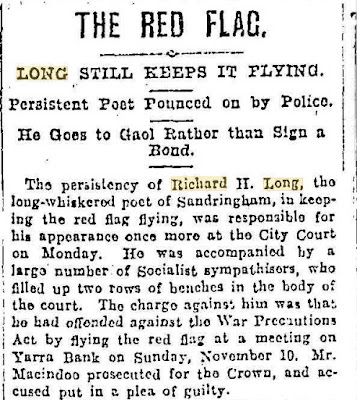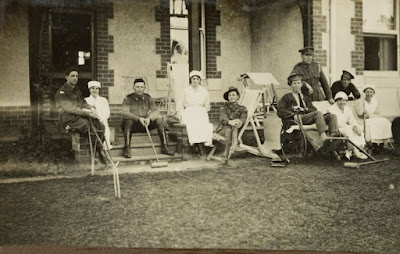Image
of Dick Long in prison. Part of Image H81.256/2, courtesy State Library of Victoria Picture Collection.
For many years I’ve been interested in a Melbourne-based group that was active in the first few decades of the twentieth century – the Free Religious Fellowship. It was led by Fred Sinclaire and its members included Eleanor Moore, Vance and Nettie Palmer, Louis Esson, Hilda Bull, William Fearn Wannan senior, Frank Wilmot (Furnley Maurice), Dick Long, Maurice and Doris Blackburn and many others who are known for their work in promoting Australian culture and for their interest in left-of-centre causes and politics.
You can read Chris Wade’s excellent
article ‘Practical idealists: the Free Religious Fellowship, the Great War and
conscription’ in the June 2017 edition of the La Trobe Journal here.
---
Many members of the Free Religious Fellowship became involved in the far left, including the woman I was researching and writing about over a decade ago – Doris McRae, a teacher, peace and social activist whose early involvement with the Free Religious Fellowship helped shape her future interests.
If you’re interested in finding out more about Doris McRae, you can download my PhD thesis, A biography of Doris McRae, here. Doris was a secondary school teacher who was a student at the University of Melbourne during the first years of World War One and was involved in anti-war actvities through her membership of the Student Christian Movement. She stayed with the peace cause throughout her long life. She, too, has a connection to Coburg – In the 1930s she taught at Coburg High School and as a member of the High Schools Branch of the Victorian Teachers’ Union returned to the school regularly in the 1940s, as Coburg High was the ‘home’ of the High Schools Branch. In many ways she saw the school as her spiritual home and her memorial service was held there in 1988, the eulogy given by the then newly appointed Minister for Education, Joan Kirner.
Despite his pacificism and his mild demeanour, Long upset the authorities by waving the red flag (literally and figuratively) as he spoke at the Yarra Bank. For his efforts he was gaoled a number of times. According to an interview he did with his friend, the poet Marjorie Pizer, at the end of his life, in December 1918 he was placed in solitary confinement for 21 days in the Model Prison at Pentridge even though it was supposed to have been abolished. He was sent to Sale Gaol where he continued to write poetry which was published in Fellowship and in the Socialist newspaper and also found himself in Melbourne Gaol where he wrote poetry from his ‘Red Flag Café’.
Doris McRae in 1947, when she was Vice-President of the Victorian Teachers' Union.
---
And now, my adventures into the
influence of WW1 on the Melbourne suburb of Coburg have led me to look again at
one of the key players in the Free Religious Fellowship – Richard Hooppell(Dick) Long. Long and his sister Minnie Isabel (Belle) were members of the
Victorian Socialist Party and the Free Religious Fellowship and their home at
Sandringham was a meeting place for rebels of all kinds.
Dick
Long wrote poetry and was a regular speaker on the Yarra Bank. He spoke against
war, against conscription and for freedom of speech.
Argus,
Monday 11 November 1918. Note that the paper was published on Armistice Day and
even though they wouldn’t have known that yet, rumours of impending peace were
rife. The offence took place the day before the armistice was signed.
Argus, 12 November 1918.
Some of Long’s poetry made it to The School Paper, for example, ‘The
Merry Shearer’ and ‘The Boobook Owl’, both published in 1926 well after his
much publicised gaol terms at the end of the war. A number of his poems were
about the war – ‘To the War-Singers, ‘The Peace Treaty’ are just two.
Despite his pacificism and his mild demeanour, Long upset the authorities by waving the red flag (literally and figuratively) as he spoke at the Yarra Bank. For his efforts he was gaoled a number of times. According to an interview he did with his friend, the poet Marjorie Pizer, at the end of his life, in December 1918 he was placed in solitary confinement for 21 days in the Model Prison at Pentridge even though it was supposed to have been abolished. He was sent to Sale Gaol where he continued to write poetry which was published in Fellowship and in the Socialist newspaper and also found himself in Melbourne Gaol where he wrote poetry from his ‘Red Flag Café’.
Rosa
Lawrence in Labor Call, 12 Dec 1918.
Truth, 16 November 1918.
Brisbane Truth, 14 September 1919.
The Socialist, 17 October 1919.
The Richard Long papers in the State
Library of Victoria’s Manuscript Collection provide a picture of what his life
in prison was like. I began this research originally because there are three photographs in the State Library’s Picture Collection that are identified as
Dick Long's shed at Pentridge Prison. The photos captured my imagination and I began
my research, but soon discovered that they were taken at Melbourne Gaol so they
are not really within the scope of this blog. However, I think you’ll agree
that they provide an intriguing insight into the prison life of this ‘Red Flag
Martyr’ and deserve their place in this blog.
Semi-enclosed corrugated iron shed or workshop
showing tables with ornaments, [Melbourne Gaol, 1919]. Image H81.256/1, courtesy State Library of Victoria Picture Collection.
Two men and two women
seated at table in corrugated iron shed, [Melbourne Gaol, 1919]. The photograph
shows R. H. Long at left, with visitors R.S. Ross, Mrs Amy
Barren and Mrs Violet Miller. Image H81.256/2, courtesy State
Library of Victoria Picture Collection. While in Melbourne Gaol in 1919, we are told that Dick ‘got on well
with his jailer and with the Governor who allowed Socialist Sunday School to be
held each week … Dick was held in the yard for condemned murderers and built a
little shack in the garden. He and his visitors used to sing the ‘Red Flag’ to
the annoyance of the Police.’ (Marjorie Pizer’s notes and Guardian, 15 January 1948)
Interior
of corrugated iron shed showing socialist posters on wall, believed to be at
Pentridge Prison, Coburg [but actually taken at Melbourne Gaol], 1919. Image H81.256/4, courtesy State Library of Victoria Picture Collection. The
Common Cause (31 July 1948), writing
about Dick after his death, said that he was ‘a craftsman and versatile artist
in many fields’ and that he ‘turned his hands to drawing, painting, decorating,
growing plants and his “cell” was a “showplace” of the gaol.’
This ‘Red Flagger’ died in August 1948,
just months after Marjorie Pizer had talked to him about his life. The obituary
she wrote appeared in the Tribune on
4 August 1948:
Sources:
Fellowship: organ of the Melbourne Free
Religious Fellowship, State Library of Victoria
Records of the
Free Religious Fellowship, MS 11878, State Library of Victoria, Manuscript Collection
Papers of Richard Long, MS 15927, Box
4834/3, State Library of Victoria, Manuscript Collection.
Australian Dictionary of Biography
entries for Doris McRae, Jennie Baines and Dick Long
State Library of Victoria Pictures
Collection
Woman
Voter, 27 October 1914
Brisbane
Worker, 20 March 1919
Argus, 10 May 1919
Brisbane
Truth, 14 September 1919
Other newspapers articles as outlined
above and retrieved from the fabulous TROVE collection
Reason in Revolt website
Chris
Wade, ‘Practical idealists: the Free Religious Fellowship, the Great War and
conscription’, La Trobe Journal 99,
March 2017, pp 95-107. Available online.
Marjorie
Pizer and the Pinchgut Press










































